Level Up Your Retrospectives: The Ultimate Guide to Effective Sprint Reviews
Sprint retrospectives are crucial for continuous improvement, but often become unproductive. This guide provides 12 powerful sprint retrospective templates, specifically designed for remote and hybrid teams. To understand the basic concept, let's define what a retrospective is. Source: Remote Work Glossary – Retrospective from joyshift. These templates will revitalize your process, driving engagement and valuable insights.
This listicle delivers practical solutions for teams struggling with ineffective retrospectives. You'll learn how to:
- Run engaging and insightful sprint retrospectives
- Boost team morale and performance
- Easily integrate these templates into your existing workflow
We'll explore each sprint retrospective template's strengths, weaknesses, ideal use cases, and implementation tips. This includes practical advice from real-world usage, going beyond simple feature lists. We'll cover the following tools:
- ClickUp
- Neatro
- Parabol
- Miro
- Retrium
- EasyRetro
- TeamRetro
- GoRetro
- Metro Retro
- Sprint Boards by Reetro
- MindMup
- Echometer
Ready to transform your retrospectives from mundane meetings into powerful engines of growth? Let's dive in.
1. ClickUp
ClickUp excels as a sprint retrospective template tool, especially for remote and hybrid teams needing robust project management features alongside retrospectives. Its customizable templates allow you to adapt the process to your team’s specific needs. Real-time collaboration ensures everyone can participate actively, regardless of location. If you're exploring tools for sprint retrospectives, it might be helpful to know more about whether Google offers a kanban board: Google Kanban Board. This resource from Tooling Studio provides valuable insights.
ClickUp's integration with tools like Slack, GitHub, and Jira streamlines workflows, keeping all relevant information centralized. Learn more about ClickUp's integrations. This makes it easy to track action items and maintain momentum after the retrospective.
Pros and Cons of Using ClickUp
Pros:
- Highly versatile and adaptable
- Comprehensive project management features
- User-friendly interface
Cons:
- Can feel overwhelming due to the extensive feature set
- May have a steeper learning curve for new users
Implementing ClickUp for Sprint Retrospectives
Start by selecting a pre-built sprint retrospective template within ClickUp. Customize the template to align with your team's preferences and the specific goals of the retrospective. Integrate with your existing tools to centralize communication and task management.
ClickUp offers a free plan, making it accessible for teams to experiment with. Paid plans provide additional features and storage. Its comprehensive features make it a powerful option for teams already using ClickUp for project management, seamlessly integrating retrospectives into existing workflows. However, its breadth of features can be a double-edged sword, potentially overwhelming new users. Focusing on the core retrospective features first is recommended for an easier onboarding experience.
2. Neatro
Neatro shines as a dedicated sprint retrospective template tool, specifically designed for fostering engaging and effective retrospectives. Its pre-built templates, coupled with real-time collaboration features, make it easy for teams to reflect on past sprints and identify areas for improvement. A key strength of Neatro lies in its emphasis on anonymous feedback, enabling team members to share their thoughts openly and honestly. This focus on psychological safety contributes to more productive retrospectives and healthier team dynamics.
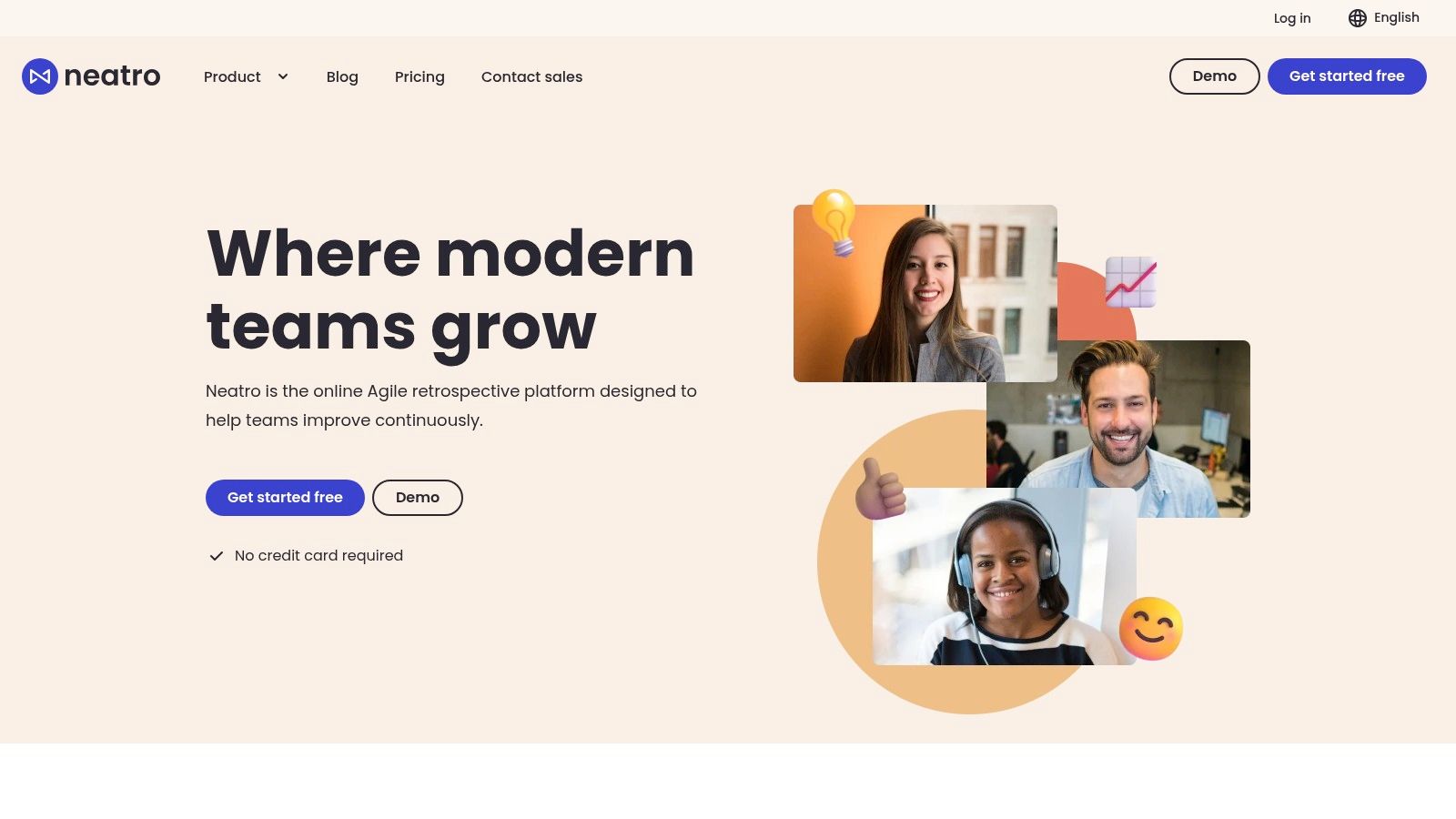
Neatro also simplifies action item tracking. You can assign tasks directly within the platform, ensuring accountability and follow-through after the retrospective. Its team health check feature allows you to monitor team morale and identify potential issues early on. This proactive approach to team well-being makes Neatro a valuable tool for remote and hybrid teams seeking to cultivate a positive and productive work environment.
Pros and Cons of Using Neatro
Pros:
- Intuitive and user-friendly interface
- Promotes honest feedback through anonymity
- Dedicated to continuous team improvement
Cons:
- Limited integrations with other project management tools
- Free version has restricted features
Implementing Neatro for Sprint Retrospectives
Begin by selecting a pre-built sprint retrospective template from Neatro's library. Customize the template to suit your team's specific needs and the goals of the retrospective. Utilize the anonymous feedback feature to encourage open communication and identify areas for improvement. Assign action items within the platform to ensure accountability and follow-through.
Neatro offers a free plan with limited features. Paid plans unlock additional functionalities and allow for larger teams. Its user-friendly design and focus on team health make it an attractive option for teams prioritizing psychological safety and continuous improvement. However, its limited integrations might be a drawback for teams heavily reliant on other project management tools.
3. Parabol
Parabol shines as a sprint retrospective template tool, especially for teams prioritizing psychological safety and streamlined Agile ceremonies. Its guided meeting formats for retrospectives, stand-ups, and sprint planning foster structured collaboration. Built-in features support both real-time and asynchronous participation, ensuring everyone can contribute effectively, regardless of location or time zone. If you're exploring retrospective tools, Parabol's open-source nature offers a unique advantage, providing free access for small teams.
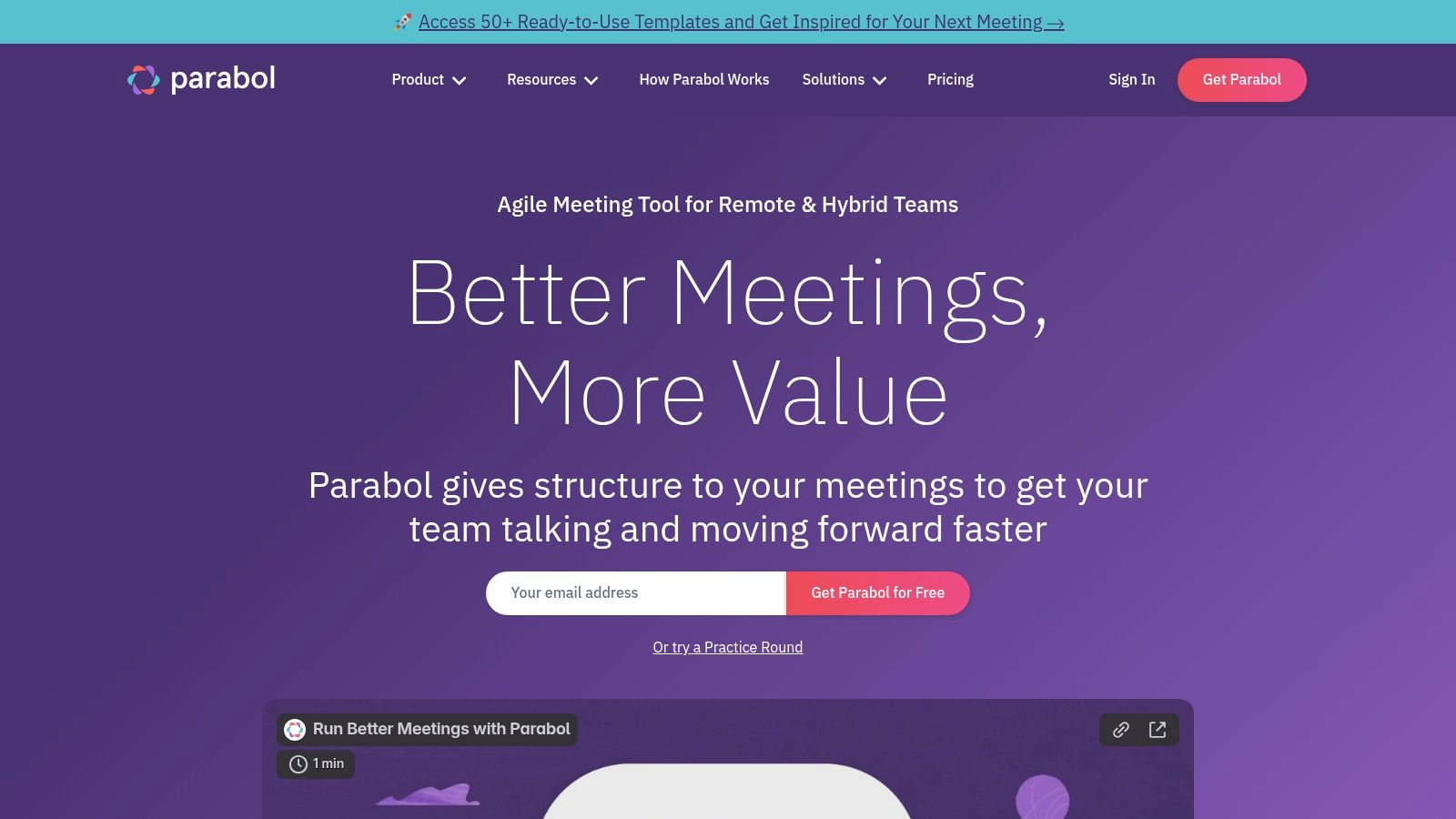
Parabol integrates with popular tools like Jira and GitHub, enhancing workflow efficiency. Automated meeting summaries and action items ensure clear follow-up after each retrospective. This keeps the team aligned and accountable for improvements.
Pros and Cons of Using Parabol
Pros:
- Supports real-time and asynchronous meetings
- Open-source with a free tier
- Anonymous feedback promotes psychological safety
Cons:
- Limited template customization
- May lack advanced features of other tools
Implementing Parabol for Sprint Retrospectives
Start by exploring Parabol's pre-built sprint retrospective templates. While customization options are somewhat limited, the structured approach guides teams through a proven process. Integrate Parabol with existing tools like Jira or GitHub to centralize task management and track progress on action items.
Parabol's free tier makes it an accessible option for small teams to try. Paid plans unlock additional features and support for larger organizations. Its focus on psychological safety and structured meetings makes Parabol an effective choice for teams seeking a straightforward, efficient approach to retrospectives. However, those requiring highly customizable templates or advanced features may find other tools better suited to their needs.
4. Miro
Miro shines as a sprint retrospective template tool thanks to its infinite canvas and diverse template library. It's ideal for remote and hybrid teams who benefit from visual collaboration. The platform allows teams to brainstorm, discuss, and vote on action items in a dynamic, engaging way. If you're comparing digital whiteboard options, you might find value in exploring alternatives: Digital Whiteboard Alternatives.
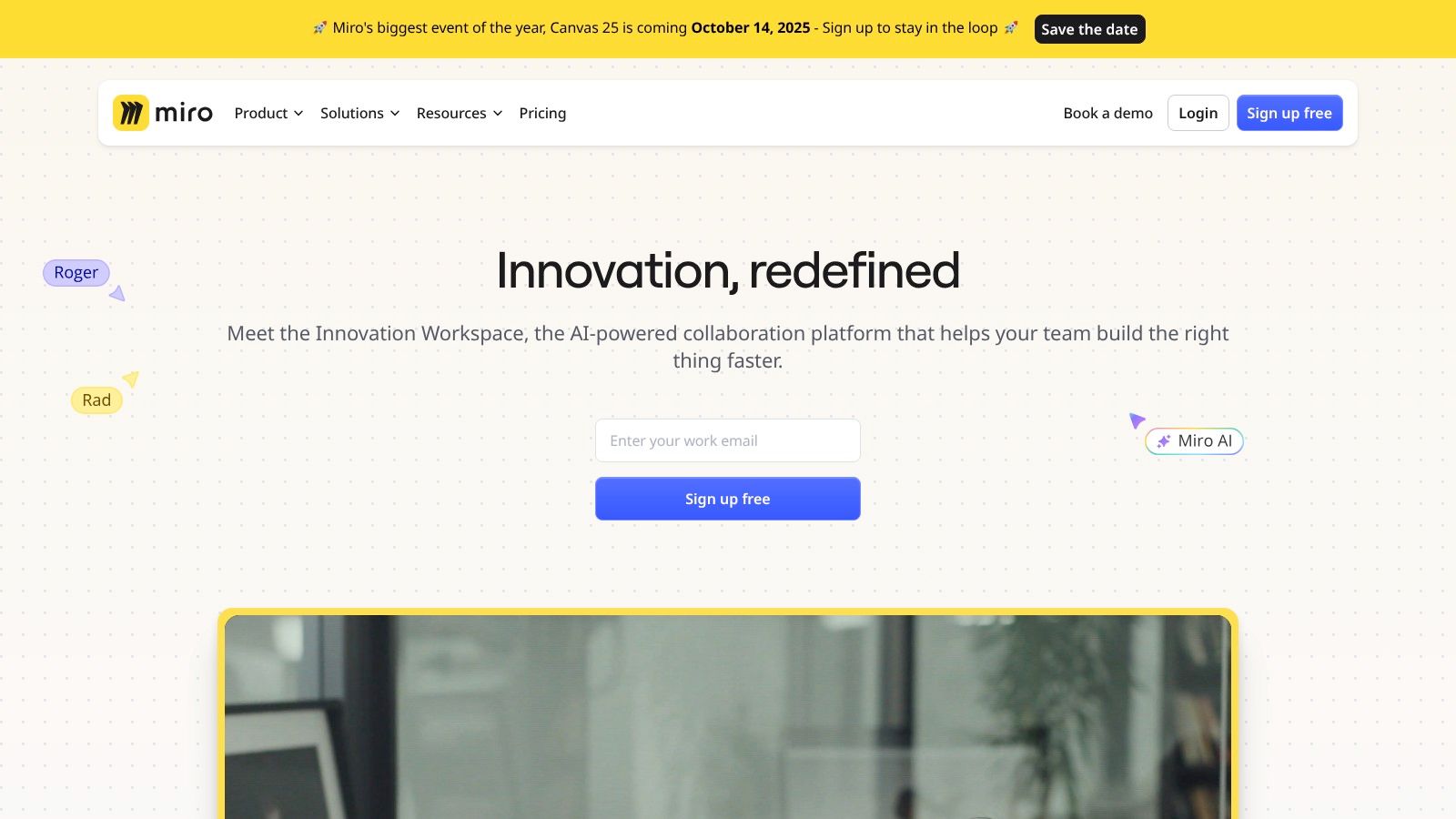
Miro integrates seamlessly with tools like Slack, Jira, and Microsoft Teams. This keeps workflows streamlined and all relevant information centralized. The visual nature of Miro facilitates a deeper understanding of discussion points and fosters a more collaborative retrospective experience.
Pros and Cons of Using Miro
Pros:
- Highly flexible and visually engaging
- Extensive template library for various retrospective formats
- Seamless integration with popular collaboration tools
Cons:
- Can be overwhelming for new users due to the vast canvas and features
- Advanced features require a paid subscription
Implementing Miro for Sprint Retrospectives
Begin by selecting a pre-built sprint retrospective template from Miro's library. Adapt the template to fit your team's specific needs and the retrospective's goals. Integrate Miro with your existing tools to streamline communication.
Miro offers a free plan with limitations. Paid plans unlock additional features like unlimited boards and advanced collaboration tools. Its visual interface makes it particularly effective for teams who value engaging and collaborative retrospectives. However, new users should start with a simple template and gradually explore the platform's features to avoid feeling overwhelmed.
5. Retrium
Retrium shines as a purpose-built tool for sprint retrospective templates, catering specifically to the needs of Agile teams. Its pre-designed templates for popular formats like Start-Stop-Continue and 4Ls make it easy to get started. The platform facilitates open communication with features like anonymous feedback collection, allowing team members to share their thoughts candidly. If your team is distributed, learning more about effective retrospective meetings, particularly with Retrium, can be beneficial: Learn more about Retrium in the context of retrospective meetings.
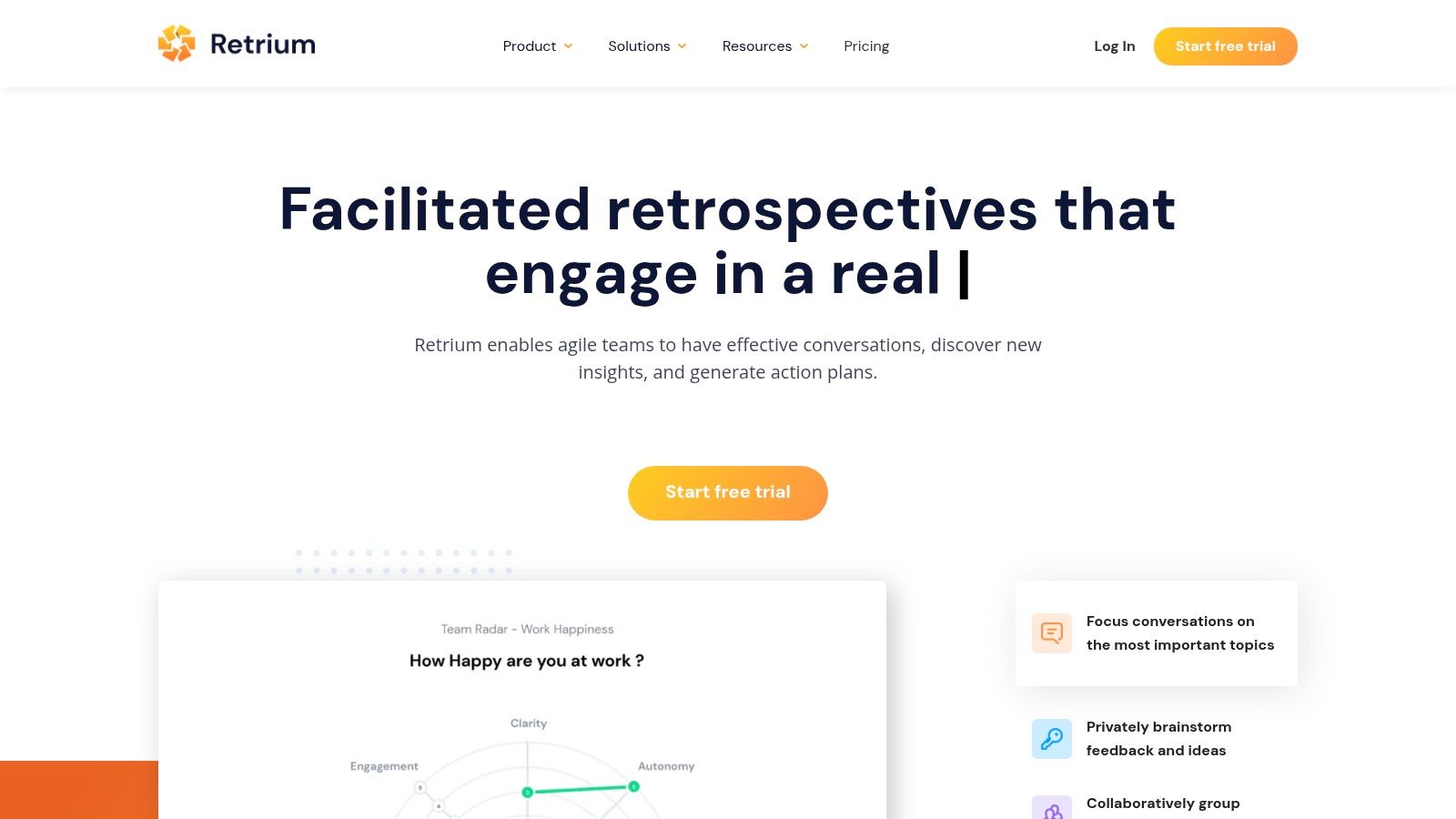
Real-time collaboration features ensure everyone can actively participate in the retrospective, regardless of their location. Retrium's integration with Jira streamlines workflows, connecting retrospective insights with your existing project management processes. The platform's analytics help track team improvement over time, providing valuable data-driven insights.
Pros and Cons of Using Retrium
Pros:
- Specifically designed for retrospectives
- Facilitates open and honest feedback
- Provides valuable insights into team dynamics
Cons:
- Can be more expensive than other options
- Functionality is focused solely on retrospectives
Implementing Retrium for Sprint Retrospectives
Begin by selecting a suitable retrospective template from Retrium's library. Encourage team members to contribute their feedback anonymously, fostering a safe space for open communication. Utilize the real-time collaboration features to discuss insights and identify action items. Integrate Retrium with your Jira instance to connect retrospective outcomes with your project management workflows.
Retrium offers a free trial, allowing teams to explore its features. Paid plans unlock additional functionalities like advanced analytics and reporting. While its dedicated focus on retrospectives makes it a powerful tool, its higher price point and specialized feature set might make it less suitable for teams seeking a more general-purpose collaboration platform. However, for teams prioritizing effective and insightful retrospectives, Retrium is a valuable investment.
6. EasyRetro
EasyRetro shines as a straightforward and intuitive sprint retrospective template tool. It's particularly well-suited for teams new to retrospectives or those prioritizing simplicity and ease of use. Its customizable boards and pre-built templates cater to various retrospective formats, allowing teams to quickly get started. If your team values anonymous feedback, EasyRetro facilitates this, encouraging open and honest reflections.
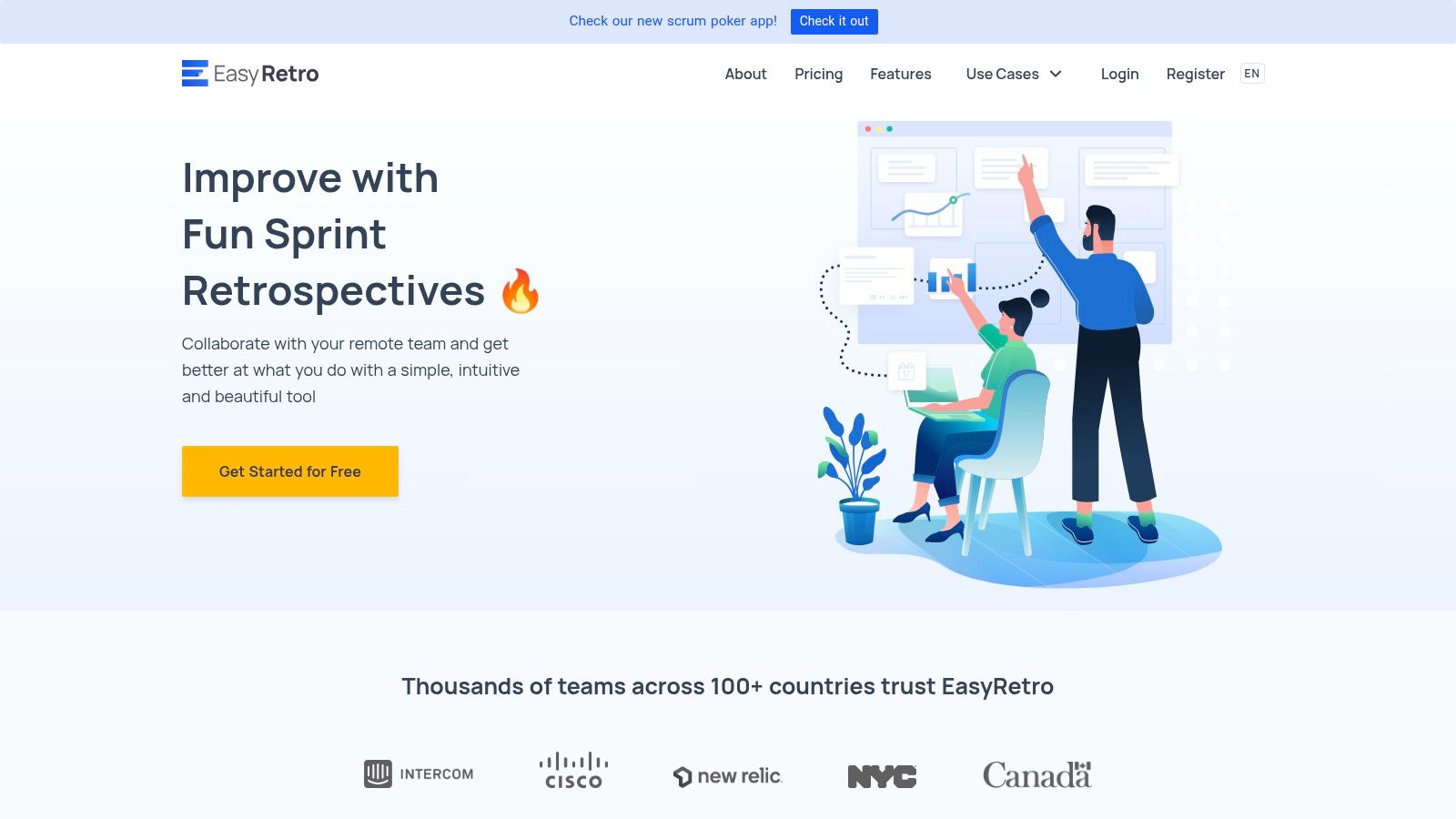
Integrations with Slack and Jira streamline workflows, connecting retrospectives with existing communication and project management tools. The export options enable easy sharing and documentation of retrospective outcomes. For distributed teams looking for a user-friendly sprint retrospective template, EasyRetro provides a solid foundation.
Pros and Cons of Using EasyRetro
Pros:
- User-friendly and easy to set up
- Affordable pricing
- Encourages honest feedback through anonymity
Cons:
- Limited advanced features
- Free plan has restrictions on board creation
Implementing EasyRetro for Sprint Retrospectives
Begin by selecting a pre-built template or creating a custom board in EasyRetro. Invite team members and guide them through the process. Utilize the anonymous feedback feature to encourage open communication. Integrate with Slack or Jira to keep information centralized.
EasyRetro's free plan offers a good starting point for smaller teams. Paid plans offer additional features and remove the limitations on board creation. While it may not have the extensive features of some other tools, its simplicity and ease of use make it an excellent choice for teams seeking an accessible and effective way to conduct sprint retrospectives. This focus on core functionality makes it less daunting for new users and allows teams to focus on the retrospective process itself.
7. TeamRetro
TeamRetro stands out as an enterprise-ready sprint retrospective template tool specifically designed for Agile retrospectives and team health checks. Its customizable templates allow you to tailor the retrospective process to your team's needs, while features like action item tracking and integrations with Jira and Slack ensure seamless workflow management. If your team prioritizes structured retrospectives and actionable outcomes, TeamRetro is worth considering.
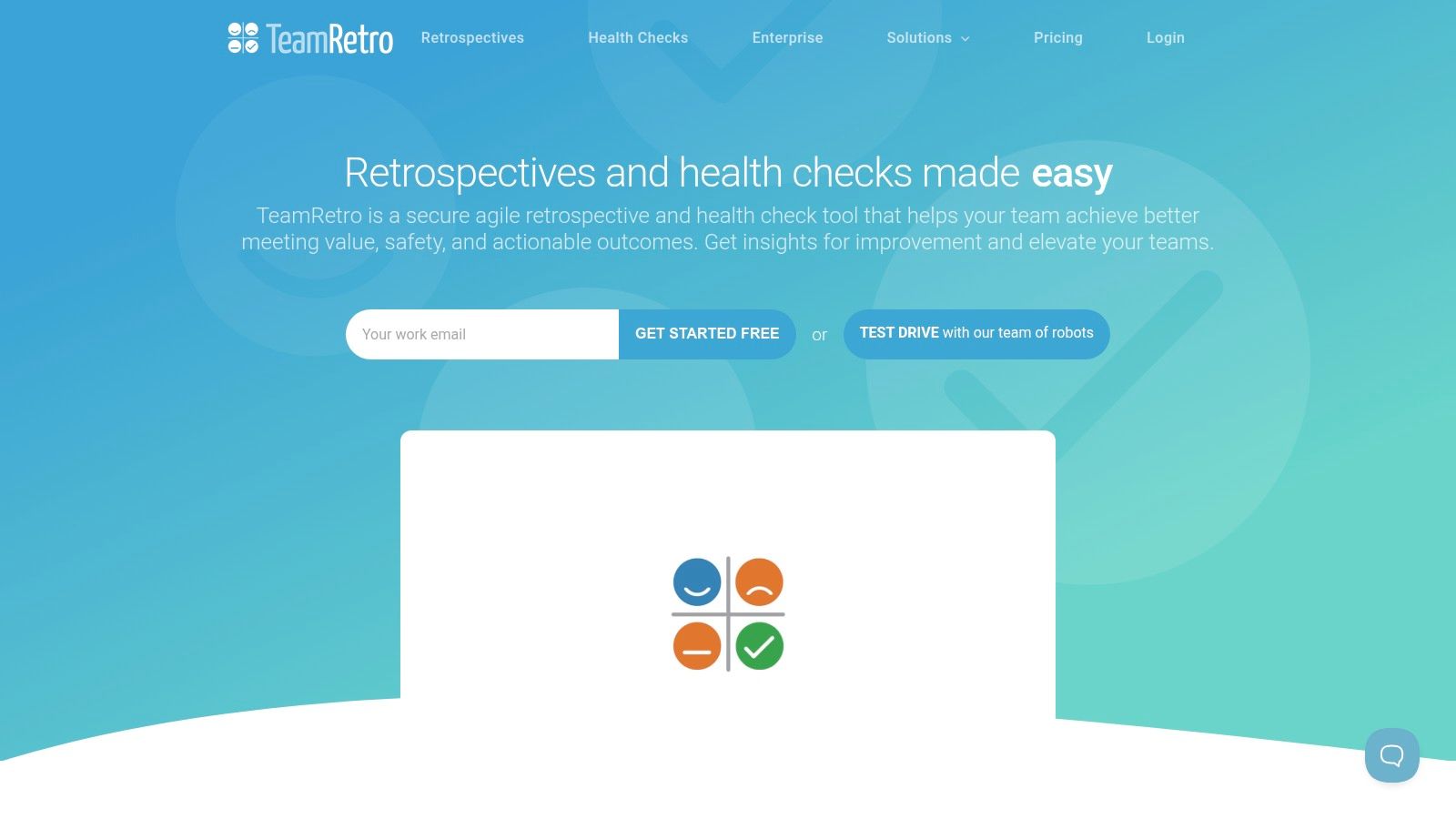
TeamRetro's focus on team health checks helps you monitor team morale and identify potential issues early on. The integration with Jira and Slack allows you to connect retrospectives with your existing project management tools. This helps centralize communication and streamlines action item tracking.
Pros and Cons of Using TeamRetro
Pros:
- Structured approach to sprint retrospectives
- Promotes team engagement and psychological safety
- Comprehensive reporting and analytics features
Cons:
- Paid plans are required for full feature access
- May have a learning curve for new users
Implementing TeamRetro for Sprint Retrospectives
Begin by selecting a pre-built sprint retrospective template from TeamRetro's library. Customize the template to align with your team’s specific context and goals. Integrate with your existing Jira and Slack instances to centralize communication and track action items effectively.
While TeamRetro offers a free trial, ongoing use requires a paid subscription. The platform's emphasis on structured retrospectives and team health makes it a valuable tool for teams committed to continuous improvement. However, be prepared for a slight learning curve as you familiarize yourself with the platform's features. Focusing on the core functionalities first will simplify the onboarding process.
8. GoRetro
GoRetro shines as a free online sprint retrospective template tool, ideal for teams seeking a simple and effective way to facilitate reflection and improvement. Its pre-built templates, combined with real-time collaboration features, make running retrospectives smooth and engaging, particularly for distributed teams. If your team values anonymity in feedback, GoRetro's anonymous feedback collection is a valuable asset, encouraging more open and honest discussions.
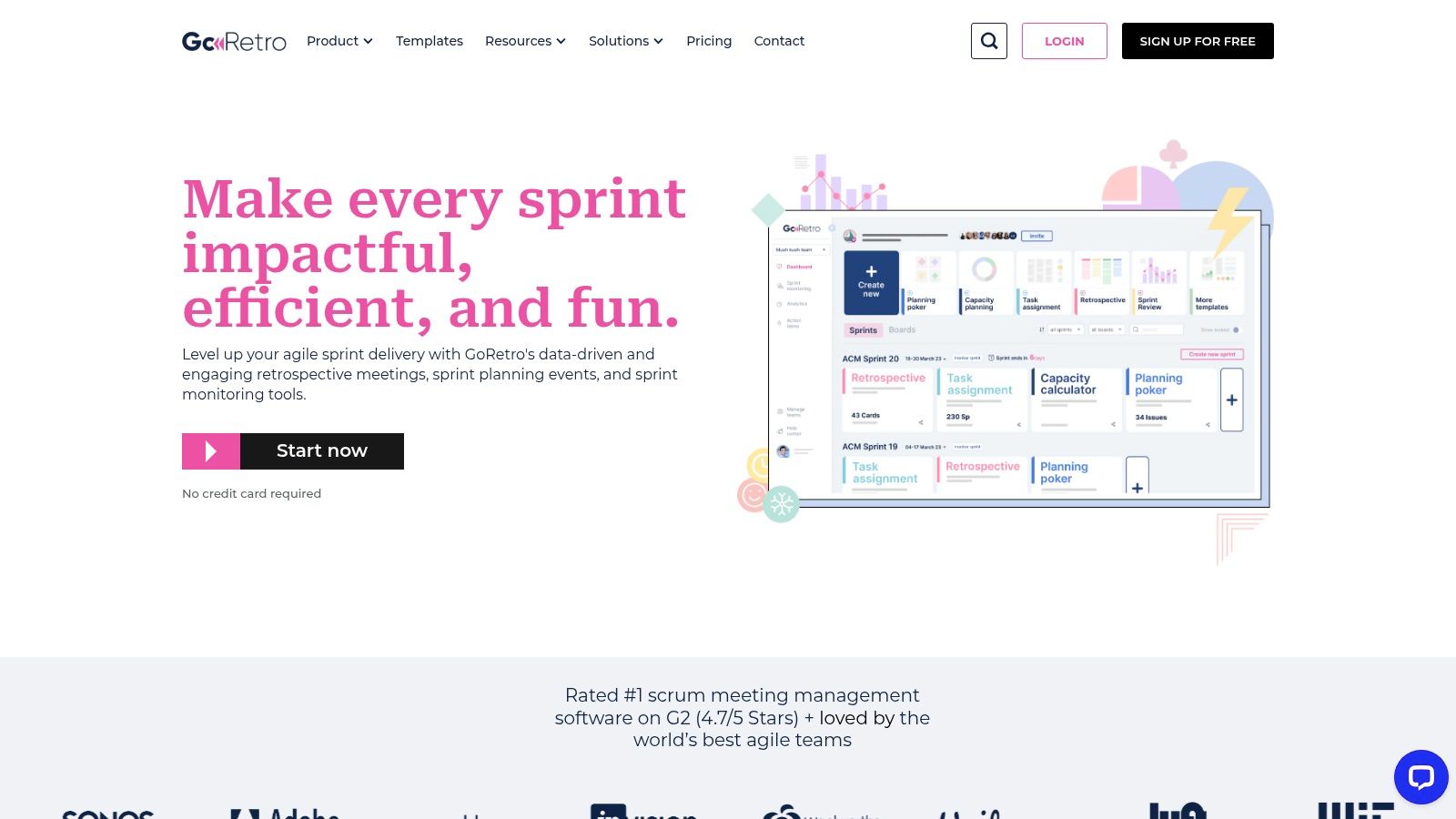
Integrations with popular tools like Jira and Slack further enhance GoRetro's utility. This seamless connection helps streamline workflows and keeps all relevant information centralized, enabling efficient action item tracking and follow-up after the retrospective. GoRetro helps ensure that insights gained translate into tangible improvements.
Pros and Cons of Using GoRetro
Pros:
- Free to use, removing cost barriers for teams.
- Easy setup and intuitive interface, minimizing the learning curve.
- Anonymous feedback promotes honest and open discussions.
Cons:
- Limited advanced features compared to paid alternatives.
- Basic reporting capabilities may restrict deeper analysis.
Implementing GoRetro for Sprint Retrospectives
Start by choosing a pre-built sprint retrospective template from GoRetro's library. Customize the template as needed to align with your team's specific context and goals for the retrospective. Integrate with your existing tools like Jira or Slack to enhance collaboration and track action items effectively. GoRetro's simplicity makes it a great option for teams new to retrospectives, or those looking for a straightforward and free tool to enhance their Agile practices. While the free version offers core functionality, exploring paid alternatives may be necessary for teams requiring advanced features and more robust reporting.
9. Metro Retro
Metro Retro shines as a free sprint retrospective template tool specifically designed for injecting fun and engagement into the process. Its interactive features, like virtual sticky notes, drawing tools, and emojis, make retrospectives more dynamic, particularly for remote and hybrid teams. If your team struggles with dry or unproductive retrospectives, Metro Retro might be the refreshing change you need.

Real-time collaboration allows everyone to participate simultaneously, regardless of location. The anonymous feedback feature can be invaluable for fostering open and honest discussions, particularly on sensitive topics. Action item tracking helps ensure follow-through after the retrospective concludes.
Pros and Cons of Using Metro Retro
Pros:
- Highly interactive and visually appealing
- Promotes team participation and engagement
- Completely free to use
Cons:
- Might feel too informal for some teams
- Limited integrations with other project management tools
Implementing Metro Retro for Sprint Retrospectives
Getting started with Metro Retro is straightforward. Simply visit the website and create a new board. Choose from several pre-built sprint retrospective templates or customize your own. Invite your team members to join and start brainstorming. The focus on visual elements and interactive features makes it particularly suited for distributed teams who might find traditional retrospectives less engaging.
Metro Retro's free nature and ease of use make it a low-barrier entry point for teams exploring online retrospective tools. While its informal style might not suit every team, its focus on engagement can revitalize the retrospective process and encourage more active participation. Its lack of integrations might be a drawback for teams heavily reliant on platforms like Jira or Slack, requiring manual transfer of action items.
10. Sprint Boards by Reetro
Sprint Boards by Reetro stands out as a valuable free sprint retrospective template tool, particularly for budget-conscious teams. Its unlimited retrospectives and users make it a scalable solution for growing organizations. The platform facilitates real-time collaboration, fostering active participation and making it a practical option for distributed teams. If your team values streamlined communication, knowing whether Google offers a Kanban board might be useful: check out this resource on Google Kanban Board.
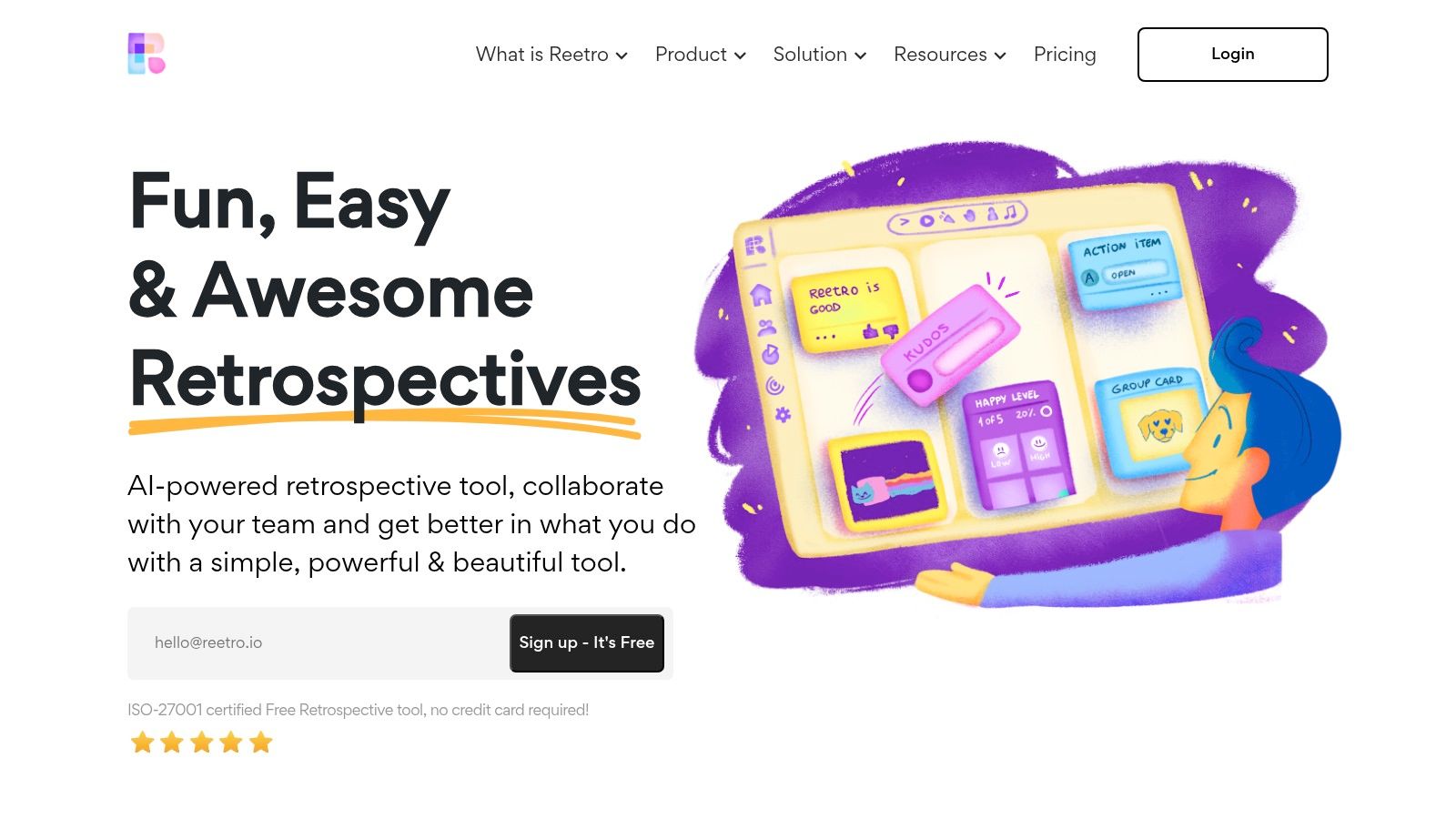
Reetro integrates with popular tools like Slack and Trello. This helps centralize communication and task management, connecting retrospectives with existing workflows. The anonymous feedback feature promotes honest reflection and helps identify areas for improvement without fear of judgment. Action tracking ensures that feedback translates into concrete steps.
Pros and Cons of Using Sprint Boards by Reetro
Pros:
- Free to use, making it accessible to all teams
- User-friendly interface simplifies the retrospective process
- Anonymous feedback encourages open communication
Cons:
- Basic interface offers limited customization
- Reporting features are less developed compared to paid alternatives
Implementing Sprint Boards by Reetro for Sprint Retrospectives
Start by creating a free account on Reetro. Choose a retrospective template or create a custom board to suit your team's needs. Integrate with Slack or Trello to connect retrospectives with your existing workflow. Facilitate the retrospective session using Reetro's real-time collaboration features. Finally, use the action tracking tools to turn feedback into actionable tasks.
Reetro's free tier, with unlimited users and retrospectives, makes it a great entry point for teams exploring retrospective tools. While its features are less extensive than paid alternatives, it offers a solid foundation for facilitating effective sprint retrospectives, particularly for teams prioritizing simplicity and affordability. The anonymous feedback feature is invaluable for fostering a safe environment for honest reflection.
11. MindMup
MindMup is a free cloud-based mind mapping tool adaptable for sprint retrospectives. It enables teams to brainstorm ideas and map action items creatively with real-time collaboration. This makes it a simple, accessible option for teams seeking a visual approach to retrospectives, particularly useful when exploring what to start, stop, or continue doing. For more structured approaches to this exercise, check out this resource: Learn more about the Start Stop Continue exercise.
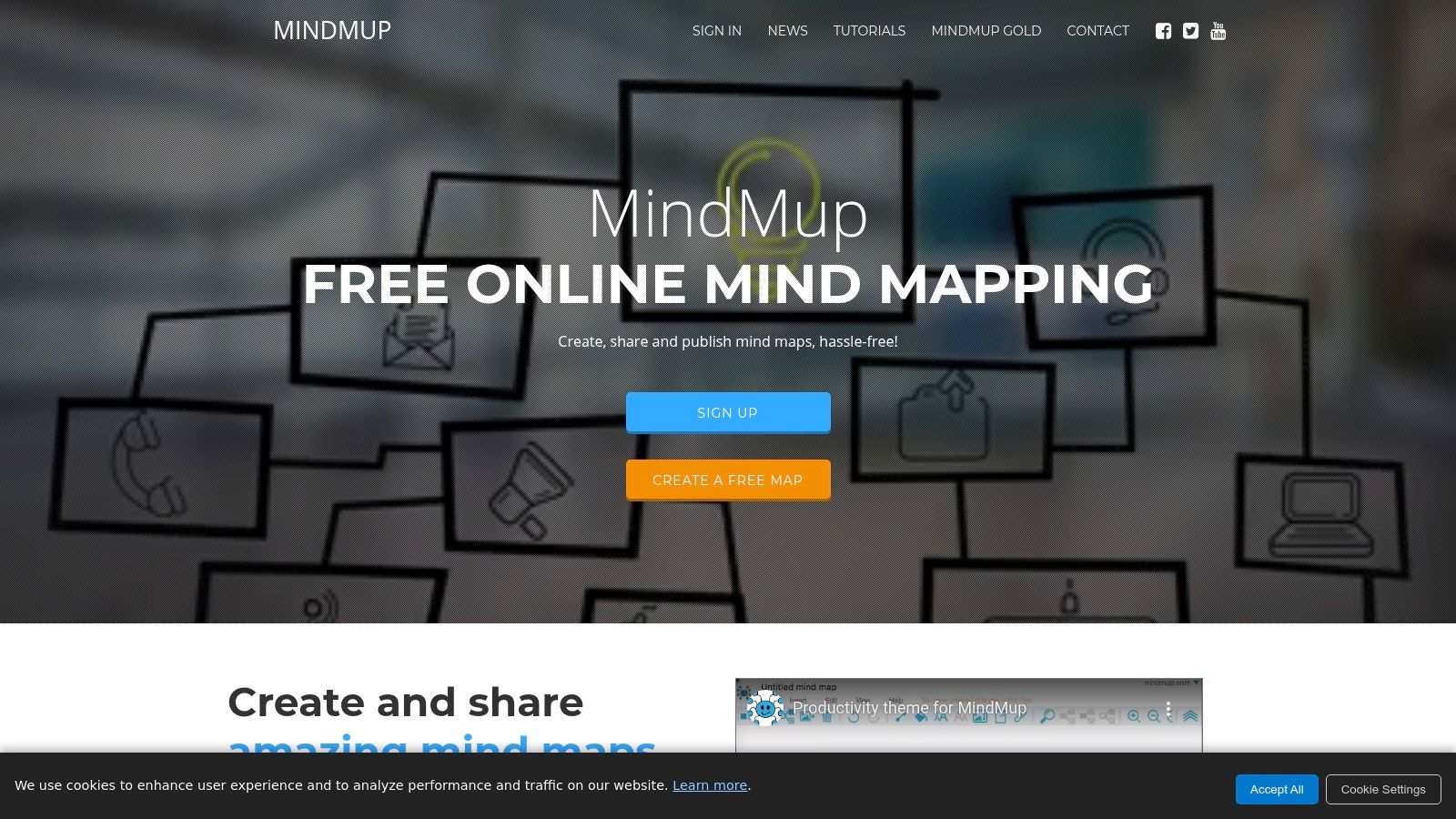
MindMup integrates with Google Drive, simplifying file storage and access. Export options to PDF or PowerPoint make sharing retrospective outcomes convenient. Keyboard shortcuts enhance the user experience, speeding up the brainstorming process. Basic use doesn't require an account, facilitating quick setup and onboarding for new users.
Pros and Cons of Using MindMup
Pros:
- Completely free for basic use
- Great for visual brainstorming
- Supports real-time collaboration
Cons:
- Lacks retrospective-specific features like voting or templates
- Limited functionality compared to dedicated retrospective tools
Implementing MindMup for Sprint Retrospectives
Start by creating a central mind map representing the sprint retrospective. Use branches for categories like "What went well," "What could be improved," and "Action items." Encourage team members to contribute ideas and comments in real-time during the retrospective. After the session, export the mind map for documentation and follow-up.
MindMup's free tier is suitable for basic sprint retrospective needs. While lacking advanced retrospective features, its simplicity and visual nature can be beneficial for teams looking to enhance brainstorming and collaboration. Its ease of use makes it a good entry point for teams new to retrospectives. However, teams requiring more structured processes or advanced features may find dedicated retrospective tools more suitable.
12. Echometer
Echometer stands out as a sprint retrospective template tool specifically designed for continuous team improvement. Its strength lies in survey-based retrospectives, mood tracking, and action item reminders. These features, combined with analytics for identifying trends, make it a powerful tool for enhancing team health. For teams already invested in the Jira ecosystem, Echometer's integration offers a seamless way to incorporate these valuable insights into existing workflows.

Echometer's focus on psychological safety sets it apart. The platform encourages honest feedback through anonymous surveys, creating a more comfortable environment for team members to share their perspectives. This leads to richer insights during sprint retrospectives and facilitates more effective action planning. The data-driven nature of Echometer allows teams to track progress and identify recurring issues. This helps teams move beyond surface-level observations and address the root causes of problems, ultimately contributing to long-term improvement.
Pros and Cons of Using Echometer
Pros:
- Focuses on psychological safety and team health
- Provides data-driven insights
- Encourages continuous improvement
Cons:
- Limited integrations with other project management tools besides Jira
- Paid plans required for full feature access
Implementing Echometer for Sprint Retrospectives
Integrating Echometer into your sprint retrospective workflow is straightforward. Start by connecting it to your Jira instance. Then, choose a suitable survey template or customize one to match your team's specific needs. Encourage team members to actively participate in the surveys and engage in discussions based on the results. Regularly reviewing the analytics dashboard helps to identify trends and track progress towards improvement goals. While the free version offers basic functionality, exploring paid plans unlocks the full potential of Echometer's insights and features. This investment can be particularly valuable for teams committed to data-driven continuous improvement and fostering a healthy team dynamic.
Sprint Retrospective Tools Feature Comparison
| Tool | Core Features & USP | User Experience ★ | Target Audience 👥 | Value & Pricing 💰 | Unique Selling Points ✨ |
|---|---|---|---|---|---|
| ClickUp | Customizable retrospectives, integrations | ★★★★☆ – Versatile but complex | Agile & cross-functional teams | 💰 Moderate, extensive features | 🏆 All-in-one PM + real-time collaboration |
| Neatro | Anonymous feedback, team health monitoring | ★★★★☆ – Intuitive & honest | Agile teams focused on feedback | 💰 Affordable, limited free plan | ✨ Anonymous & morale tracking |
| Parabol | Guided retrospectives, async & real-time | ★★★★☆ – Open-source flexibility | Small to mid Agile teams | 💰 Free tier + paid plans | 🏆 Open-source + async collaboration |
| Miro | Infinite canvas, powerful visual tools | ★★★★☆ – Highly flexible | Creative & Agile teams | 💰 Paid plans for full access | ✨ Visual collaboration + integrations |
| Retrium | Multiple formats, analytics, Jira integration | ★★★★☆ – Focused and insightful | Agile teams prioritizing retros | 💰 Higher-priced | 🏆 Analytics & deep retrospective focus |
| EasyRetro | Customizable boards, exportable | ★★★☆☆ – Simple & approachable | Small to medium teams | 💰 Low cost, free limited plan | ✨ Easy setup & affordability |
| TeamRetro | Team health, analytics, Jira & Slack | ★★★★☆ – Structured and detailed | Enterprises & large Agile teams | 💰 Paid plans required | 🏆 Enterprise-grade reports & health |
| GoRetro | Pre-built templates, anonymous feedback | ★★★☆☆ – Free & easy | Small Agile teams on budget | 💰 Free | ✨ Free, simple & honest feedback |
| Metro Retro | Interactive tools, emojis, visual engagement | ★★★☆☆ – Fun & engaging | Teams seeking creative retros | 💰 Free | ✨ Visual, interactive & fun retros |
| Sprint Boards by Reetro | Unlimited retrospectives & users, voting | ★★★☆☆ – User-friendly & free | Small teams & startups | 💰 Free | ✨ Unlimited free usage & voting |
| MindMup | Mind mapping, real-time collaboration | ★★★☆☆ – Visual but limited | Teams needing visual brainstorming | 💰 Free basic use | ✨ No account needed & Google Drive integration |
| Echometer | Survey retrospectives, mood tracking, analytics | ★★★★☆ – Data-driven & insightful | Agile teams focused on health | 💰 Paid plans | 🏆 Continuous improvement via surveys |
Transforming Team Dynamics: The Power of Effective Sprint Retrospectives
This exploration of sprint retrospective templates has highlighted a range of powerful tools designed to facilitate team reflection and continuous improvement. From established platforms like Miro and ClickUp to specialized tools like Parabol and Retrium, each offers unique features and functionalities catering to different team needs and preferences. Whether your team thrives on visual collaboration, structured activities, or streamlined simplicity, there's a template out there to enhance your retrospective process.
Choosing the Right Template for Your Team
Selecting the appropriate sprint retrospective template depends heavily on your team's specific context. Consider the following factors:
- Team Size: Some templates work better for smaller teams while others scale effectively for larger groups.
- Team Culture: A playful team might appreciate a more visually engaging template, while a more formal team might prefer a structured approach.
- Remote vs. Hybrid: The chosen tool should seamlessly support remote collaboration and integrate with your existing communication platforms.
- Integration Needs: Check if the tool integrates with project management software your team already uses.
Key Takeaways for Successful Retrospectives
Regardless of the chosen template, certain principles hold true for effective retrospectives:
- Psychological Safety: Create a safe space for open and honest feedback.
- Actionable Outcomes: Focus on identifying specific, actionable steps for improvement.
- Regular Cadence: Consistent retrospectives foster a culture of continuous growth.
- Adaptation and Iteration: Regularly evaluate and adapt your retrospective process based on team feedback.
Implementing Your Chosen Sprint Retrospective Template
Once you've selected a template, ensure a smooth implementation by following these steps:
- Introduce the tool to your team: Explain the purpose and benefits of the chosen template.
- Provide training or resources: Ensure everyone understands how to use the tool effectively.
- Start with a simple format: Begin with a basic retrospective format and gradually introduce more complex activities.
- Gather feedback: Regularly check in with your team to see how the template is working and make adjustments as needed.
By leveraging these diverse sprint retrospective templates, your team can cultivate a culture of continuous improvement, open communication, and increased productivity. Remember to adapt the chosen template to your team's specific context and iterate on the process for optimal results. Consistent, well-structured retrospectives empower teams to not just reflect on past performance, but to actively shape a more collaborative and successful future. Don't forget that robust pre-retrospective brainstorming is key for a productive session. Fuel your next sprint retrospective with rich insights gathered using a brainstorming tool like Bulby. Bulby allows for asynchronous idea generation and organization, ensuring a comprehensive collection of thoughts and feedback to analyze during your retrospective, maximizing its impact on team growth.

